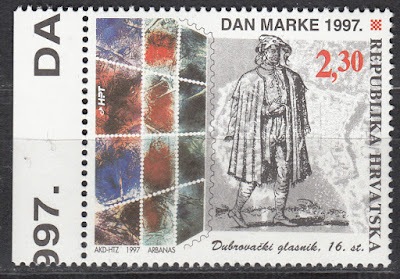Here are some events that happened on June 27th. It could be an event or a person that died or was born on that day
1358 – The Republic of Ragusa is founded.
The Republic of Ragusa (Latin: Respublica Ragusina; Italian: Repubblica di Ragusa; Croatian: Dubrovačka Republika, lit. 'Dubrovnik Republic'; Venetian: Repùblega de Raguxa) was an aristocratic maritime republic centered on the city of Dubrovnik (Ragusa in Italian, German and Latin; Raguxa in Venetian) in Dalmatia (today in southernmost Croatia) that carried that name from 1358 until 1808. It reached its commercial peak in the 15th and the 16th centuries, before being conquered by Napoleon's French Empire and formally annexed by the Napoleonic Kingdom of Italy in 1808. It had a population of about 30,000 people, of whom 5,000 lived within the city walls. Its motto was "Non bene pro toto libertas venditur auro", which means "Liberty is not sold for all the gold in the world"
Stamps from Croatia commemorating Dubrovnik
1574 Died: Giorgio Vasari, Italian historian, painter, and architect (b. 1511)
Giorgio Vasari (30 July 1511 – 27 June 1574) was an Italian painter, architect, engineer, writer, and historian, best known for his Lives of the Most Excellent Painters, Sculptors, and Architects, considered the ideological foundation of art-historical writing, and basis for biographies of several Renaissance artists including Leonardo da Vinci. Vasari designed the Tomb of Michelangelo in the Basilica of Santa Croce, Florence that was completed in 1578. Based on Vasari's text about Giotto's new manner of painting, Jules Michelet suggested for the first time the term Renaissance in his Histoire de France (1835), a term adopted by historiography and still in use today.
Aside from his career as a painter, Vasari was also successful as an architect. His loggia of the Palazzo degli Uffizi by the Arno opens up the vista at the far end of its long narrow courtyard. It is a unique piece of urban planning that functions as a public piazza, and which, if considered as a short street, is unique as a Renaissance street with a unified architectural treatment. The view of the Loggia from the Arno reveals that, with the Vasari Corridor, it is one of very few structures that line the river which are open to the river itself and appear to embrace the riverside environment.
In Florence, Vasari also built the long passage, now called Vasari Corridor, which connects the Uffizi with the Palazzo Pitti on the other side of the river. The enclosed corridor passes alongside the River Arno on an arcade, crosses the Ponte Vecchio and winds around the exterior of several buildings. It was once the home of the Mercado de Vecchio.
He also renovated the medieval churches of Santa Maria Novella and Santa Croce. At both he removed the original rood screen and loft, and remodeled the retro-choirs in the Mannerist taste of his time. In Santa Croce, he was responsible for the painting of The Adoration of the Magi which was commissioned by Pope Pius V in 1566 and completed in February 1567. It was recently restored, before being put on exhibition in 2011 in Rome and in Naples. Eventually it is planned to return it to the church of Santa Croce in Bosco Marengo (Province of Alessandria, Piedmont).
In 1562 Vasari built the octagonal dome on the Basilica of Our Lady of Humility in Pistoia, an important example of high Renaissance architecture.
In Rome, Vasari worked with Giacomo Barozzi da Vignola and Bartolomeo Ammannati at Pope Julius III's Villa Giulia.
Italian stamp commemorating Vasari's architectural work
1831 Died: Sophie Germain, French mathematician and physicist (b. 1776)
Marie-Sophie Germain (1 April 1776 – 27 June 1831) was a French mathematician, physicist, and philosopher. Despite initial opposition from her parents and difficulties presented by society, she gained education from books in her father's library, including ones by Leonhard Euler, and from correspondence with famous mathematicians such as Lagrange, Legendre, and Gauss (under the pseudonym of «Monsieur LeBlanc»). One of the pioneers of elasticity theory, she won the grand prize from the Paris Academy of Sciences for her essay on the subject. Her work on Fermat's Last Theorem provided a foundation for mathematicians exploring the subject for hundreds of years after. Because of prejudice against her sex, she was unable to make a career out of mathematics, but she worked independently throughout her life. Before her death, Gauss had recommended that she be awarded an honorary degree, but that never occurred. On 27 June 1831, she died from breast cancer. At the centenary of her life, a street and a girls’ school were named after her. The Academy of Sciences established the Sophie Germain Prize in her honor
French stamp depicting Sophie Germain




No comments:
Post a Comment